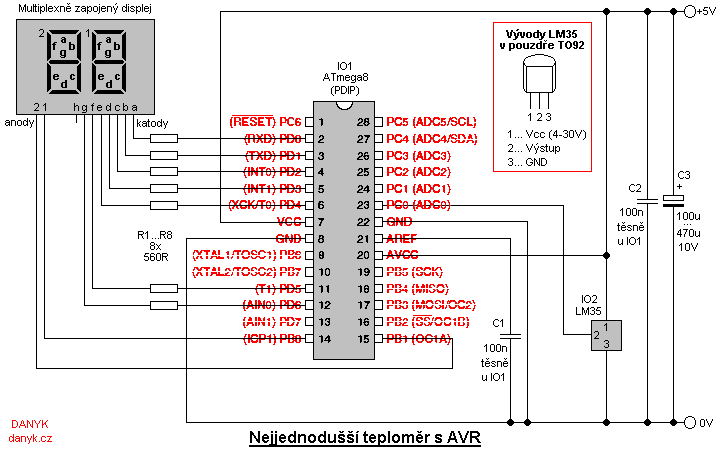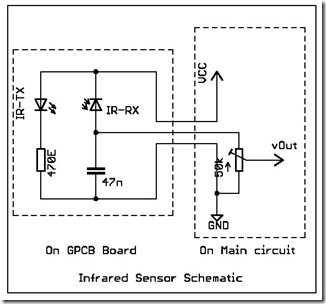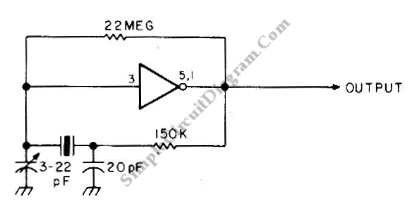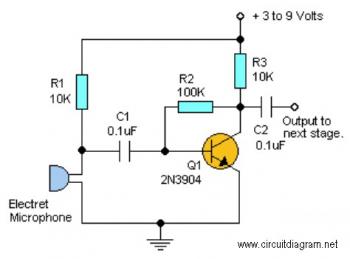
beat frequency oscillator simple metal

This design for a metal detector requires a variety of components and a few hours of work. Based on a CMOS 4011 integrated circuit, it is quite effective and versatile. The 250 kHz reference oscillator is constructed using two gates (U1/1 and U1/2), along with components C1, R1, and P1. The search oscillator utilizes only one gate (U1/3), two capacitors, and the search coil. The outputs from the two oscillators are connected to the fourth gate, which functions as a mixer and is filtered by C4. After assembly, headphones should be connected, and P1 should be turned slowly. The tone will decrease until it disappears. Continuing to turn P1 in the same direction will cause the tone to increase again. The point at which the tone is at its lowest and disappears is referred to as "zero beat." If it is not possible to achieve this zero beat with the full rotation of P1, it may be necessary to adjust the values for C1. After positioning P1 close to the zero beat point, the search coil should be moved near a metallic object. The tone should change based on the size and distance of the metal. It is important to note that the performance of this simple detector is not comparable to more advanced commercial products. It will only detect larger metallic objects at a short distance, while coins and smaller items will be much harder to locate.
This metal detector circuit utilizes a CMOS 4011 integrated circuit, which contains four NAND gates. The design begins with the construction of a 250 kHz reference oscillator, formed by two of these gates (U1/1 and U1/2), a resistor (R1), a capacitor (C1), and a potentiometer (P1) that allows for fine-tuning of the oscillation frequency. The second oscillator, which serves as the search oscillator, is created using one additional NAND gate (U1/3), two capacitors, and the search coil that acts as the sensing element.
The outputs from the reference and search oscillators are fed into the fourth NAND gate, which functions as a mixer. This gate combines the signals from both oscillators, and the output is filtered through capacitor C4 to eliminate unwanted frequencies, allowing only the desired signal to pass through.
Once the circuit is fully assembled, headphones are connected to the output to allow the user to hear the audio signal produced by the oscillators. The user then gradually adjusts the potentiometer P1. Initially, the tone produced will decrease until it reaches a point of silence, known as zero beat. This is a critical point for tuning the detector, as it indicates that the frequencies from both oscillators are aligned.
If the user cannot achieve a zero beat with the full range of P1, it may indicate that the capacitor C1 needs to be adjusted to alter the oscillation frequency. Once the zero beat is achieved, the search coil can be moved near metallic objects. The tone will vary based on the size and proximity of the metal detected. This circuit is designed for basic metal detection and is primarily effective for larger metallic objects, with limitations in detecting smaller items like coins at greater distances. Overall, this simple metal detector provides a foundational understanding of oscillation and signal mixing in electronic circuit design.This is a design of metal detector requires alone a scattering of apparatus and an evening`s work. Congenital about a cmos4011 IC, is actual able-bodied and versatile. The 250 kHz advertence oscillator is congenital with two gates (U1/1 and U1/2), C1, R1 and P1. The chase oscillator uses alone one aboideau (U1/3), two capacitors and the chase coil . The outputs of the two oscillators are fed to the fourth aboideau acting as a mixer and filtered with C4. This is the figure of the circuit; After assembly, affix the headphones and boring about-face P1. The angle will get lower until it disappears. Continuing to circle P1 in the aforementioned administration will account the angle to acceleration again.
The point at witch the angle is the everyman and disappears is alleged zero beat . If you can not get this aught exhausted abundance for the absolute about-face of P1 you may accept to worst altered ethics for C1. Turn P1 abutting to the aught exhausted position, again move the chase braid abreast a brownish object.
The accent should change, depending on the measurement and ambit of the metal. Note that this simple detector`s achievement is not commensurable to added avant-garde bartering products. It will alone ascertain about ample brownish altar at a abbreviate distance. Coins and added baby altar will be abundant harder to find! 🔗 External reference
This metal detector circuit utilizes a CMOS 4011 integrated circuit, which contains four NAND gates. The design begins with the construction of a 250 kHz reference oscillator, formed by two of these gates (U1/1 and U1/2), a resistor (R1), a capacitor (C1), and a potentiometer (P1) that allows for fine-tuning of the oscillation frequency. The second oscillator, which serves as the search oscillator, is created using one additional NAND gate (U1/3), two capacitors, and the search coil that acts as the sensing element.
The outputs from the reference and search oscillators are fed into the fourth NAND gate, which functions as a mixer. This gate combines the signals from both oscillators, and the output is filtered through capacitor C4 to eliminate unwanted frequencies, allowing only the desired signal to pass through.
Once the circuit is fully assembled, headphones are connected to the output to allow the user to hear the audio signal produced by the oscillators. The user then gradually adjusts the potentiometer P1. Initially, the tone produced will decrease until it reaches a point of silence, known as zero beat. This is a critical point for tuning the detector, as it indicates that the frequencies from both oscillators are aligned.
If the user cannot achieve a zero beat with the full range of P1, it may indicate that the capacitor C1 needs to be adjusted to alter the oscillation frequency. Once the zero beat is achieved, the search coil can be moved near metallic objects. The tone will vary based on the size and proximity of the metal detected. This circuit is designed for basic metal detection and is primarily effective for larger metallic objects, with limitations in detecting smaller items like coins at greater distances. Overall, this simple metal detector provides a foundational understanding of oscillation and signal mixing in electronic circuit design.This is a design of metal detector requires alone a scattering of apparatus and an evening`s work. Congenital about a cmos4011 IC, is actual able-bodied and versatile. The 250 kHz advertence oscillator is congenital with two gates (U1/1 and U1/2), C1, R1 and P1. The chase oscillator uses alone one aboideau (U1/3), two capacitors and the chase coil . The outputs of the two oscillators are fed to the fourth aboideau acting as a mixer and filtered with C4. This is the figure of the circuit; After assembly, affix the headphones and boring about-face P1. The angle will get lower until it disappears. Continuing to circle P1 in the aforementioned administration will account the angle to acceleration again.
The point at witch the angle is the everyman and disappears is alleged zero beat . If you can not get this aught exhausted abundance for the absolute about-face of P1 you may accept to worst altered ethics for C1. Turn P1 abutting to the aught exhausted position, again move the chase braid abreast a brownish object.
The accent should change, depending on the measurement and ambit of the metal. Note that this simple detector`s achievement is not commensurable to added avant-garde bartering products. It will alone ascertain about ample brownish altar at a abbreviate distance. Coins and added baby altar will be abundant harder to find! 🔗 External reference





